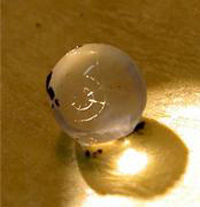Fighting Presbyopia: Laser Treatment of Aging Eye Lenses May Help

Eye with eight gliding planes cut in the lens using laser technology.<br>
Millions of people suffer from presbyopia, aging of the eye lens. When natural aging occurs, among other things, the eye lens becomes less elastic, making it difficult for the lens to accommodate to different distances. Older people tend to hold reading material at arms length, for example, due to presbyopia.
Up to present, therapy has not been able to increase the elasticity of the eye lens. Thus, the Laser Zentrum Hannover (LZH), together with the Laserforum in Cologne and the Eye Clinic in Bonn (all in Germany) have carried out first studies to find a way to increase the flexibility of the eye lens.
Investigations from the last few years at the LZH have shown a laser can be used to cut fine grooves in the eye lens. The grooves form gliding planes in the tissue of the lens and can restore elasticity. A special kind of laser is used for cutting, a femtosecond laser (fs-laser), which is not only extremely precise, but which also makes very fine cut grooves. Since the size and position of the lens differ from patient to patient, control and monitoring of the cutting is done via optical coherence tomography (OCT).
More that 200 pig eyes and over 40 human autopsy lenses were successfully treated in vitro using laser technology. Cut configuration and the laser parameters were optimized to retain the biomechanics of the lens. Furthermore, some animal lenses were also treated in vivo.
Investigations have shown that light reflexes due to the cutting pattern appear immediately after treatment, but later disappear. Other investigations on long-term complications, especially concerning cataracts and clouding of the lens, have not yet been completed, but are positive in tendency.
The fibers of human eye lenses are in principal similar in size and structure to the animal lenses which were treated. However, whether it is possible to use fs-laser technology for treating presbyopia without causing clouding of the lens is still subject to further testing. In summary, the results already achieved are so positive, that there is a very promising outlook on the future treatment of presbyopia using laser technology.
Contact:
Laser Zentrum Hannover e.V.
Michael Botts
Hollerithallee 8
D-30419 Hannover
Germany Tel.: +49 511 2788-151
Fax: +49 511 2788-100
E-Mail: m.botts@lzh.de
Media Contact
More Information:
http://www.lzh.deAll latest news from the category: Health and Medicine
This subject area encompasses research and studies in the field of human medicine.
Among the wide-ranging list of topics covered here are anesthesiology, anatomy, surgery, human genetics, hygiene and environmental medicine, internal medicine, neurology, pharmacology, physiology, urology and dental medicine.
Newest articles

Combatting disruptive ‘noise’ in quantum communication
In a significant milestone for quantum communication technology, an experiment has demonstrated how networks can be leveraged to combat disruptive ‘noise’ in quantum communications. The international effort led by researchers…

Stretchable quantum dot display
Intrinsically stretchable quantum dot-based light-emitting diodes achieved record-breaking performance. A team of South Korean scientists led by Professor KIM Dae-Hyeong of the Center for Nanoparticle Research within the Institute for…

Internet can achieve quantum speed with light saved as sound
Researchers at the University of Copenhagen’s Niels Bohr Institute have developed a new way to create quantum memory: A small drum can store data sent with light in its sonic…





















